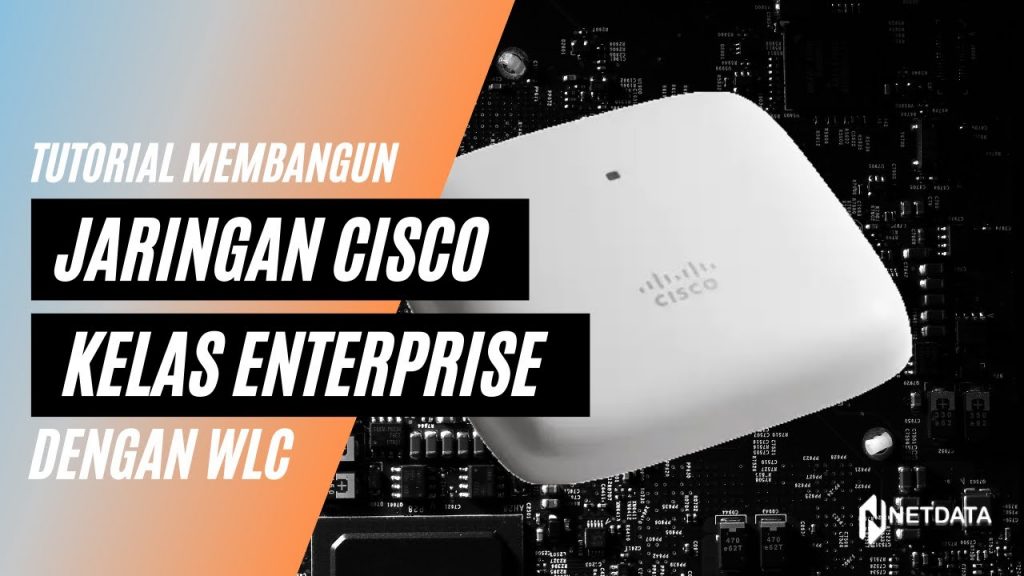Tutorial on Building an Enterprise Class Cisco Network with WLC | Cisco WLC by Netdata tutorial – A wireless LAN controller (WLC) is a networking component that manages wireless network access points and allows wireless devices to connect to the network. WLC (Cisco WLC) is typically used to gain control of your routers, switches, firewalls, gateways and other devices.
Table of Contents
Advantages of Using Cisco WLC
If there is a piece of hardware from Cisco, there is definitely a good advantage over other brands. What are the benefits or advantages for those of you using Cisco WLC?
Quickly Configure Multiple Access Points
If you work for a company and you are in a network administrator position, when you are going to build a wireless network, of course, you will be faced with conditions where there are a lot of access points. With the WLC controller, you can configure as many access points as possible without having to set them one by one.
Networking with Cisco WLC
There are several things that you should pay attention to before building a network with Cisco WLC.
Prepare the Lab
Before getting into the tutorial, here is an example of a lab that you should prepare before building a Cisco WLC network.
Keterangan:
1. Access Point
The access point validates WLC to complete the discovery & merge process. Validation on the access point and WLC are mutual authentication mechanisms.
2. Router Mikrotik
This proxy router is connected to the internet on port 1. And on port 2 it is connected to a power ejector. On port 3, connect the WLC Controller. And on port 4, connect to the device that will be used for configuration such as a laptop.
3. Power Ejector
Connect the power ejector earlier to the access point
4. Laptop
This laptop is used for management to build a Cisco WLC network.
After all these things are ready, it’s time to configure it. You can use a console cable.
If everything is ready, it’s time to configure.
Configuring Cisco WLC
Preparation
- The first thing you should pay attention to is make sure that all of the hardware is connected to the internet.
- Also make sure the IP on the LAN network has been configured and enabled by the DHCP server. The goal is that later when you connect to the access point, you will automatically get an IP.
- If everything is done, now the configuration can be started.
Configuration
- Open the PuTTY application, then select serial. You have to match the other series on your laptop or computer.
- To find out other laptop serials, you can enter the Device Manager, select the Ports menu (COM & LPT)
There you will be able to find out the other serial ports, in this case COM7. - You just need to adjust earlier on the PuTTY application.
- If so then fill in the serial line and click Open
Initial Installation Steps
- Boot WLC and connect via serial connection to the console.
- Enter the settings to reset the system to factory settings with a command like this:
- Recover-Config
- Follow the initial configuration, making sure to stop auto-install by typing “yes” after the controller boots.
- Enter a name for the system
- Enter an administrative name like “root” or “admin”
- Enter an administrative password
- Enable or disable link aggregation
- Enter the management IP address for remote login to WLC.
- Enter the management netmask, such as 255.255.255.0
- Enter the default gateway
- Enter the VLAN identifier, if there is no VLAN enter 0.
- Enter 1 as the management interface port.
- Enter the DHCP server address, usually the same as the default gateway.
- Enter a non-existent fictitious IP for the virtual gateway IP.
- Enter the multicast address.
- Enter a name for “Mobility / RF Group”
- Enter the SSID.
- Enable DHCP link mode.
- Allow static IP.
- Enable / Disable RADIUS server.
- Enter “ID” as the country code.
- Activate all networks by typing “yes”
- Turn off Auto-RF “no”
- Configure the NTP server, you can configure it like this:
Just copy the IP and return to the previous step.
- Run the following command to activate the web console and then reset WLC.
- secureweb network config enable
- active webmode network config
- network config mgmt-via-wireless enable
- system reset
- Run the Ethernet cable from the switch to port 1 WLC.
- Log in to the web console using the previous management IP set.
- Under the “WLAN” tab, select the network created during setup.
- Open “Security”
- Enable “PSK” and enter the password for the network. And apply.
Access Point Configuration
- Plug the wireless antenna into the POE switch and leave it on, the booting and recognition process from WLC may take some time.
- Open the “Wireless” tab from the WLC web console.
- Select the access point you wish to configure.
- Select “Clear All Config” at the bottom of the page to restore the antenna to factory settings.
- Once the antenna is booted up and recognized again, edit the name.
- Assign a static IP address by enabling the “Static IP” box and entering the details.
Connect with the network that was created,
If you are connected and can also be used to surf the internet, then these steps have been successful.
![]()
![]()


